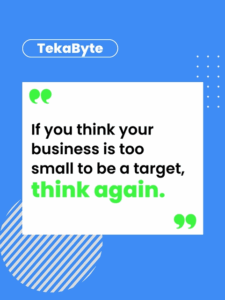The $60 Million Holiday Scam (And How to Keep Your Business Out of the Headlines)
Hey friend,
Can I tell you a story that still makes my stomach drop?
Last December, a team member at a growing company got a message from their “CEO.” You know, the kind that says, “Quick, grab some Apple gift cards for client gifts. Scratch the backs and send me the codes.”
Weird, sure. But it was the holidays. It was chaotic. And the message looked legit.
By the time the employee realized something felt off, the gift cards were gone. The scammer cashed out. And the company was left holding the bill.
That alone is frustrating. But there’s a bigger story I want you to hear…
That same month, a chemical company in Europe lost $60 million—yes, million—after an employee got a series of totally normal-looking emails requesting wire transfers. They thought the requests were from a trusted partner. Turns out, they weren’t.
The transfers were made. The money vanished. And just like that, over half the company’s annual profits disappeared.
🎁 Holiday Season = Hacker Season
If you’re thinking, “That would never happen to us—we’re just a small business,” I hate to break it to you… That’s exactly who scammers are targeting.
Here’s why:
-
Your team is juggling a million things.
-
You’re processing more payments than usual.
-
And everyone’s running on peppermint lattes and a prayer.
Cybercriminals know this. And they pounce.
Just last year, gift card scams alone cost U.S. businesses over $217 million. And email-based fraud made up nearly 3 out of every 4 cyber incidents. That’s a lot of folks getting tricked at exactly the worst time.
🎅 The Top 5 Holiday Scams You Need to Warn Your Team About
1. “The Boss Needs Gift Cards”
📱 A text or email from a manager asking for gift cards—fast.
It feels urgent. It uses real names. And it’s usually a lie.
✅ How to prevent it: Set a clear policy: No gift cards without two approvals. Ever. And remind your team—no exec will ever request these over text.
2. Invoice Swaps & Bank Info Fakes
📧 “Hey! Just updating our payment details—can you use this new account?”
These scams sneak into vendor threads and show up right when year-end invoices are flying.
✅ How to prevent it: Make it a rule: Any payment or banking changes must be confirmed by phone—using a number you already know.
3. Fake Shipping Notices
📦 Texts or emails that look like UPS/FedEx/USPS asking you to click a link to reschedule.
Spoiler alert: It’s malware in a Santa suit.
✅ How to prevent it: Bookmark official carrier sites and teach your team to go directly there—never click the link.
4. Sketchy Holiday Attachments
📂 Files with names like “Holiday_Bonus_List.xls” or “Party_Schedule.pdf.”
They look festive. But open the wrong one, and boom—malware.
✅ How to prevent it: Block risky macros. Scan every attachment. And create a culture where it’s okay to ask first, open later.
5. Fake Charities or “Company Match” Fundraisers
💔 Heartwarming emails with fake links asking for holiday donations.
These prey on generosity—and they steal your money or info.
✅ How to prevent it: Share a list of approved charities and have all donations go through official channels.
🛡️ Why These Attacks Work (And How to Fight Back)
These scams aren’t dumb. They’re not the “Nigerian prince” stuff from 2006. They’re slick, targeted, and often personalized.
They succeed because:
-
We’re busy.
-
We trust our inbox.
-
And we don’t always double-check.
But here’s the good news: Most of them can be stopped with simple changes.
✨ Companies that run phishing drills reduce their risk by 60%.
✨ Turning on multi-factor authentication (MFA) blocks 99% of login-based attacks.
✨ A five-minute team huddle can save you from a six-figure mistake.
✅ Your Holiday Cyber Safety Checklist
Before the tinsel hits the fan, here’s what I recommend:
-
The Two-Person Rule: No large transactions without verbal confirmation through a different channel.
-
Gift Card Policy: No gift cards by email or text. Ever.
-
Vendor Verification: Always call to confirm payment changes—don’t trust the email.
-
MFA Everything: Email, cloud apps, banking—every login should have a second step.
-
Brief Your Team: Share this blog or print a one-pager for the break room.
💔 The Real Cost? It’s Not Just the Money
Yes, $60 million is a gut punch. But even smaller scams can knock the wind out of you, especially if you’re running lean like so many small businesses in Virginia and North Carolina:
-
Your team loses time cleaning up.
-
Your clients lose trust.
-
Your budget takes a hit.
-
And your stress? Through the roof.
The average cost of a single email scam? $129,000. That’s not just inconvenient. That’s closing-your-doors kind of scary.
🎁 Give Your Business the Gift of Peace of Mind
This season, give yourself the gift of calm.
You don’t need to become a cybersecurity expert. You just need someone who’s watching your back, while you take care of your people.
And if that sounds like something you’d love (or desperately need), let’s talk.
A quick 15-minute call could save you thousands—and a whole lot of headaches.
👉 Schedule Your Free Holiday Security Assessment
Because the holidays should be full of joy—not fraud reports.
You’ve got enough on your plate. Let us handle the tech.
With peace of mind and peppermint mochas,
– TekaByte
